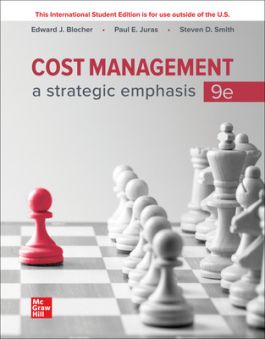Cost Management: A Strategic Emphasis ISE
PART ONE: Introduction to Strategy, Cost Management, andCost Systems
Chapter: 1 Cost Management and Strategy
Chapter 2: Implementing Strategy: The Value Chain, theBalanced Scorecard, and the Strategy Map
Chapter 3: Basic Cost Management Concepts
Chapter 4: Job Costing
Chapter 5: Activity-Based Costing and Customer ProfitabilityAnalysis
Chapter 6: Process Costing
Chapter 7: Cost Allocation: Departments, Joint Products, andBy-Products
PART TWO: Planning and Decision Making
Chapter 8: Cost Estimation
Chapter 9: Short-Term Profit Planning: Cost-Volume-Profit(CVP) Analysis
Chapter 10: Strategy and the Master Budget
Chapter 11: Decision Making with a Strategic Emphasis
Chapter 12: Strategy and the Analysis of Capital Investments
Chapter 13: Cost Planning for the Product Life Cycle: TargetCosting, Theory of Constraints, and Strategic Pricing
PART THREE: Operational-Level Control
Chapter 14: Operational Performance Measurement: Sales,Direct Cost Variances, and the Role of Nonfinancial Performance Measures
Chapter 15: Operational Performance Measurement: IndirectCost Variances and Resource Capacity Management
Chapter 16: Operational Performance Measurement: FurtherAnalysis of Productivity and Sales
Chapter 17: The Management and Control of Quality
PART FOUR: Management-Level Control
Chapter 18: Strategic Performance Measurement: Cost Centers,Profit Centers, and the Balanced Scorecard
Chapter 19: Strategic Performance Measurement: InvestmentCenters and Transfer Pricing
Chapter 20: Management Compensation, Business Analysis, andBusiness Valuation
While the text does include coverage of traditional costing topics (e.g., job-order costing, process costing, service-department cost allocations, and accounting for joint and by-products), its primary strength is the linkage of these topics, as well as more contemporary topics, to an organization's strategy. And with Connect, an easy-to-use homework and learning management solution that embeds learning science and award-winning adaptive tools to improve student outcomes, instructors receive a course solution that includes high quality content and assessment paired with assignments that help students build the skills they need to succeed.

